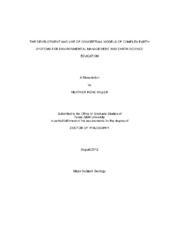| dc.description.abstract | Conceptualizations of earth's surficial systems pose challenges to scientists, novice teachers, and students alike, because they are variable, non-linear, and dynamic. Developing scientific models of these systems allow users to visualize, manipulate, reason, and organize knowledge about the system under investigation.
This dissertation is focused on two research strands using scientific modeling of surficial earth systems. The first strand is focused on a coastal ecosystem impacted by soil salinization and water availability. This study used topography, soil type, soil conductivity, and plant community to develop a conceptualized toposequence of this region to support our understanding of the dominant source of soil salinity.
The second strand is twofold: novice understanding of scientific modeling and conceptual model development. The first study evaluates novice science teachers' approach to scientific modeling of a system which they have no prior knowledge about. Through observations, we assessed their science process skills, compared these results to novices and experts working with the same system, and found that novice teachers perform more like novices when faced with scientific investigations. This research will guide future teacher professional development programs to explicitly focus on science process skills and their role in scientific modeling. The second study characterizes the impact of an inquiry-based learning (IBL) module versus a traditionally structured laboratory exercise. The experimental groups were taught using IBL pedagogical techniques through manipulation of large-scale data sets, multiple representations, and a physical model. The control groups were taught traditionally. The groups were not significantly different prior to exposure to the lesson. Pre/post-expressed conceptual models indicate that the experimental group had greater increases in critical thinking. Written reports indicated they further gained in content knowledge, communication of findings, and experimental design. Overall results showed that teaching though IBL coupled with multiple representations had significant positive influence on student's conceptual model development.
This synergistic dissertation between science and science education is a model for those wanting to pursue an academic career in geoscience education. This type of synergy between teaching and research allows for greater achievement in and outside the classroom ultimately improving overall education. | en |


